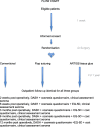A multi-center, double blind randomized controlled trial evaluating flap fixation after mastectomy using sutures or tissue glue versus conventional closure: protocol for the Seroma reduction After Mastectomy (SAM) trial
- PMID: 30119663
- PMCID: PMC6098656
- DOI: 10.1186/s12885-018-4740-8
A multi-center, double blind randomized controlled trial evaluating flap fixation after mastectomy using sutures or tissue glue versus conventional closure: protocol for the Seroma reduction After Mastectomy (SAM) trial
Abstract
Background: Seroma formation is a common complication after mastectomy and is associated with delayed wound healing, infection, skin flap necrosis, patient discomfort and repeated visits to the out patient clinic to deal with seroma and its sequelae. Closing the dead space after mastectomy seems to be key in reducing seroma and its complications. Various methods have been described to reduce the dead space after mastectomy: closed suction drainage, quilting of the skin flaps and application of adhesive tissue glues. The aim of this trial is to compare seroma formation and its sequelae in the various methods of flap fixation.
Methods: This is a multicenter, double-blind, randomized controlled trial in female breast cancer patients undergoing mastectomy, with or without axillary clearance. Exclusion criteria consist of breast conserving therapy, direct breast reconstruction and incapacity to comprehend implications and extent of study and unable to sign for informed consent. A total of 336 patients will be randomized. Patients will be randomly allocated to one of three treatment arms consisting of flap fixation using ARTISS tissue glue with a low suction drain, flap fixation using sutures and a low suction drain or conventional wound closure (without flap fixation) and low suction drainage. Follow up will be conducted up to twelve months post surgery. The primary outcome is the number of seroma aspirations and secondary outcomes consist of number of out patient clinic visits, surgical skin infection rate, shoulder function, cosmesis, health-related quality of life and costs and cost-effectiveness (cost/QALY).
Discussion: This is the first study of its kind to evaluate the effect of flap fixation and its sequelae (ie seroma aspirations, number of out patient clinic visits, infection, shoulder function, patient assessed cosmesis, quality of life and cost-effectiveness) in a double blind randomized controlled trial.
Trial registration: This trial was approved by the hospitals' joint medical ethical committee (14-T-21, 2 June 2014). The SAM Trial is registered in ClinicalTrials.gov since October 2017, Identifier: NCT03305757 .
Keywords: Cost-effectiveness; Flap fixation; Mastectomy; QALY; Quilting; Seroma aspiration; Seroma formation; Shoulder function; Tissue glue.
Conflict of interest statement
Ethics approval and consent to participate
Written informed consent will be obtained from all trial participants. This trial was approved by the hospitals’ joint medical ethical committee (
Consent for publication
Not applicable.
Competing interests
The authors declare that they have no competing interests.
Publisher’s Note
Springer Nature remains neutral with regard to jurisdictional claims in published maps and institutional affiliations.
Similar articles
-
Reducing seroma formation and its sequelae after mastectomy by closure of the dead space: The interim analysis of a multi-center, double-blind randomized controlled trial (SAM trial).Breast. 2019 Aug;46:81-86. doi: 10.1016/j.breast.2019.05.002. Epub 2019 May 7. Breast. 2019. PMID: 31103811 Clinical Trial.
-
A single-center, randomized, non-inferiority study evaluating seroma formation after mastectomy combined with flap fixation with or without suction drainage: protocol for the Seroma reduction and drAin fRee mAstectomy (SARA) trial.BMC Cancer. 2020 Aug 7;20(1):735. doi: 10.1186/s12885-020-07242-0. BMC Cancer. 2020. PMID: 32767988 Free PMC article.
-
Reducing Seroma Formation and Its Sequelae After Mastectomy by Closure of the Dead Space: A Multi-center, Double-Blind Randomized Controlled Trial (SAM-Trial).Ann Surg Oncol. 2021 May;28(5):2599-2608. doi: 10.1245/s10434-020-09225-8. Epub 2020 Oct 19. Ann Surg Oncol. 2021. PMID: 33078318 Clinical Trial.
-
A systematic review of flap fixation techniques in reducing seroma formation and its sequelae after mastectomy.Breast Cancer Res Treat. 2018 Jan;167(2):409-416. doi: 10.1007/s10549-017-4540-x. Epub 2017 Oct 16. Breast Cancer Res Treat. 2018. PMID: 29039118
-
A systematic review of seroma formation following drain-free mastectomy.Eur J Surg Oncol. 2021 Apr;47(4):757-763. doi: 10.1016/j.ejso.2020.10.010. Epub 2020 Oct 10. Eur J Surg Oncol. 2021. PMID: 33051116
Cited by
-
Conventional suture with prolonged timing of drainage is as good as quilting suture in preventing seroma formation at pectoral area after mastectomy.World J Surg Oncol. 2021 May 12;19(1):148. doi: 10.1186/s12957-021-02257-8. World J Surg Oncol. 2021. PMID: 33980267 Free PMC article.
-
Mastectomy Without Drains Reduces Cost with No Detriment to Patient Outcome.Cureus. 2019 Jul 17;11(7):e5160. doi: 10.7759/cureus.5160. Cureus. 2019. PMID: 31528512 Free PMC article.
-
The QUILT study: quilting sutures in patients undergoing breast cancer surgery: a stepped wedge cluster randomized trial study.BMC Cancer. 2023 Jul 17;23(1):667. doi: 10.1186/s12885-023-11154-0. BMC Cancer. 2023. PMID: 37460983 Free PMC article. Clinical Trial.
-
Negative pressure wound therapy does not decrease postoperative wound complications in patients undergoing mastectomy and flap fixation.Sci Rep. 2021 May 5;11(1):9620. doi: 10.1038/s41598-021-89036-3. Sci Rep. 2021. PMID: 33953312 Free PMC article.
-
Intraoperative hypertonic saline irrigation preventing seroma formation and reducing drain secretion in extended endoscopic hernia and linea alba reconstruction glue.Hernia. 2019 Dec;23(6):1291-1296. doi: 10.1007/s10029-019-01956-2. Epub 2019 May 4. Hernia. 2019. PMID: 31055707
References
-
- Kumar S, et al. Post-mastectomy seroma: a new look into the aetiology of an old problem. J R Coll Surg Edinb. 1995;40:292–294. - PubMed
-
- Woodworth PA, et al. Seroma formation after breast cancer surgery; incidence and predicting factors. Am Surg. 2000;66(5):444–450. - PubMed
-
- Tadych K, et al. Postmastectomy seromas and wound drainage. Surg Gynecol Obstet. 1987;165(6):483–487. - PubMed
Publication types
MeSH terms
Substances
Associated data
LinkOut - more resources
Full Text Sources
Other Literature Sources
Medical


